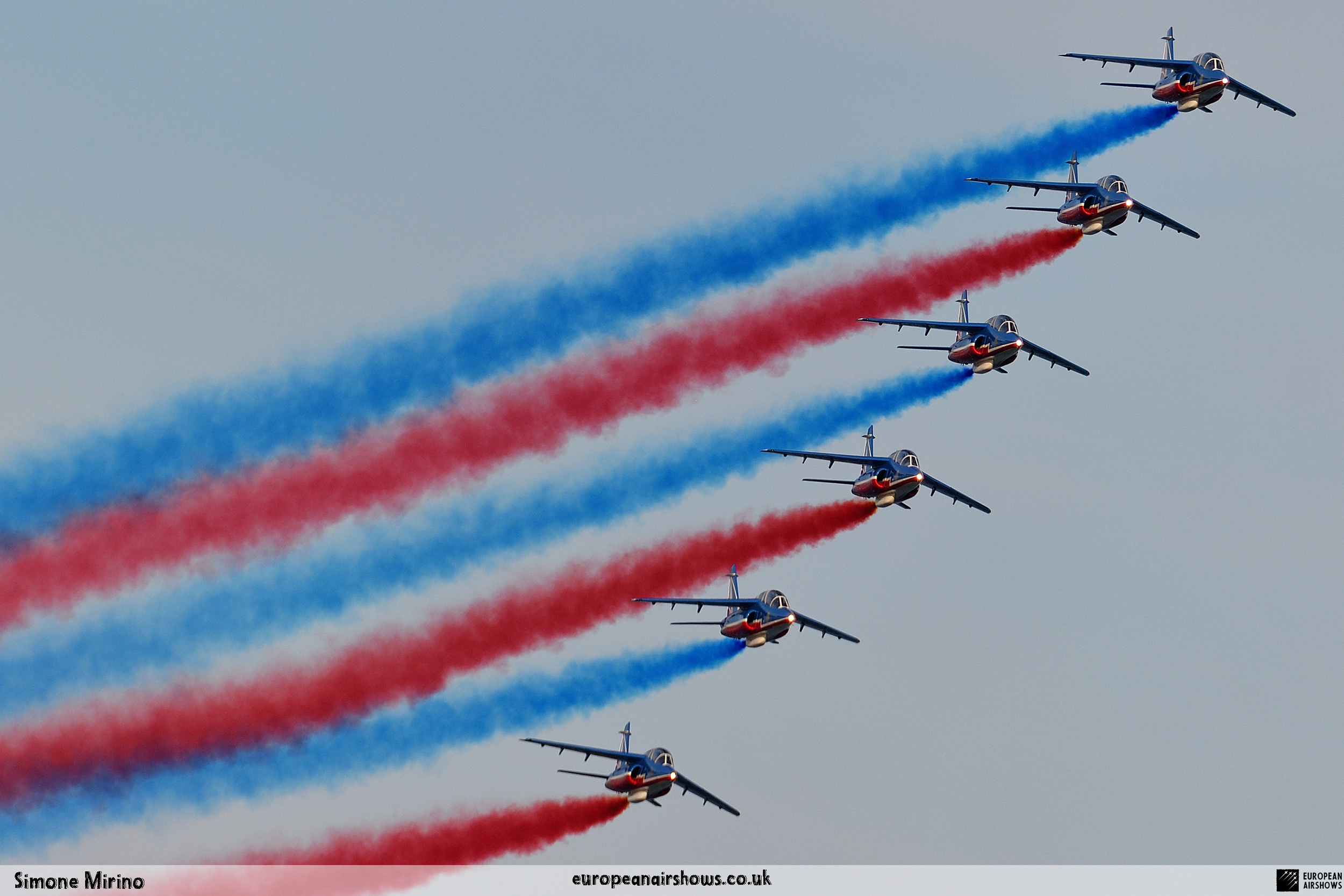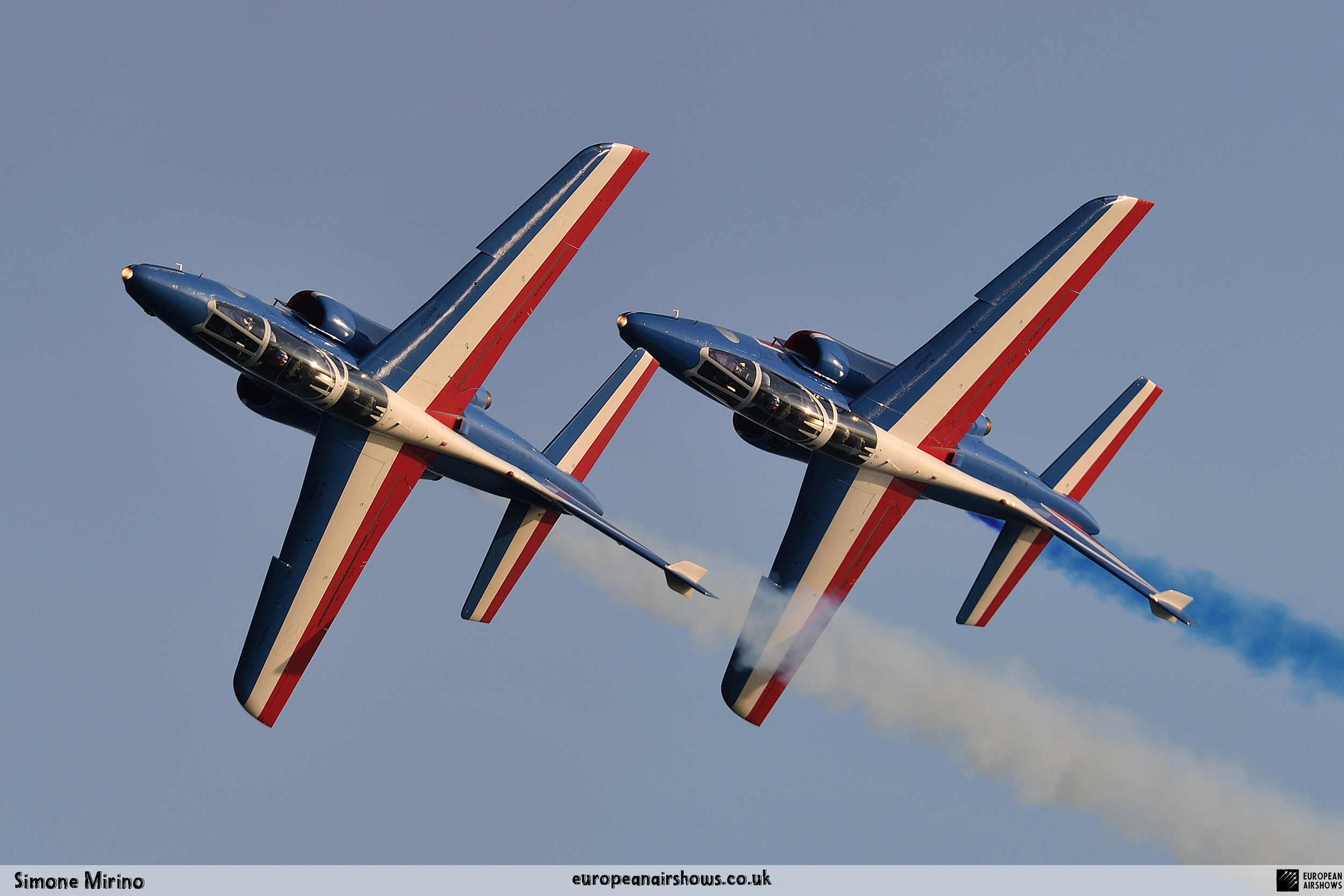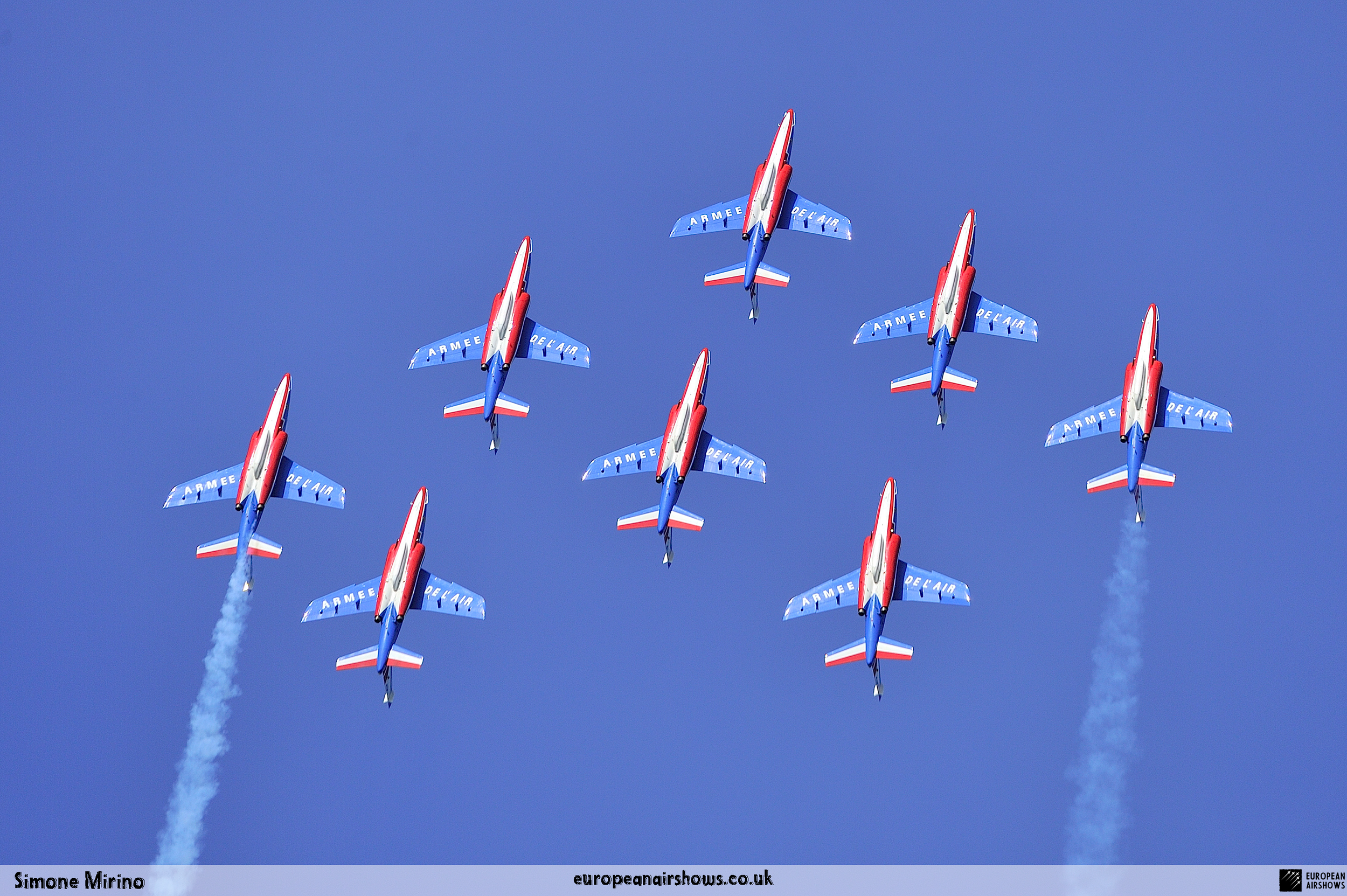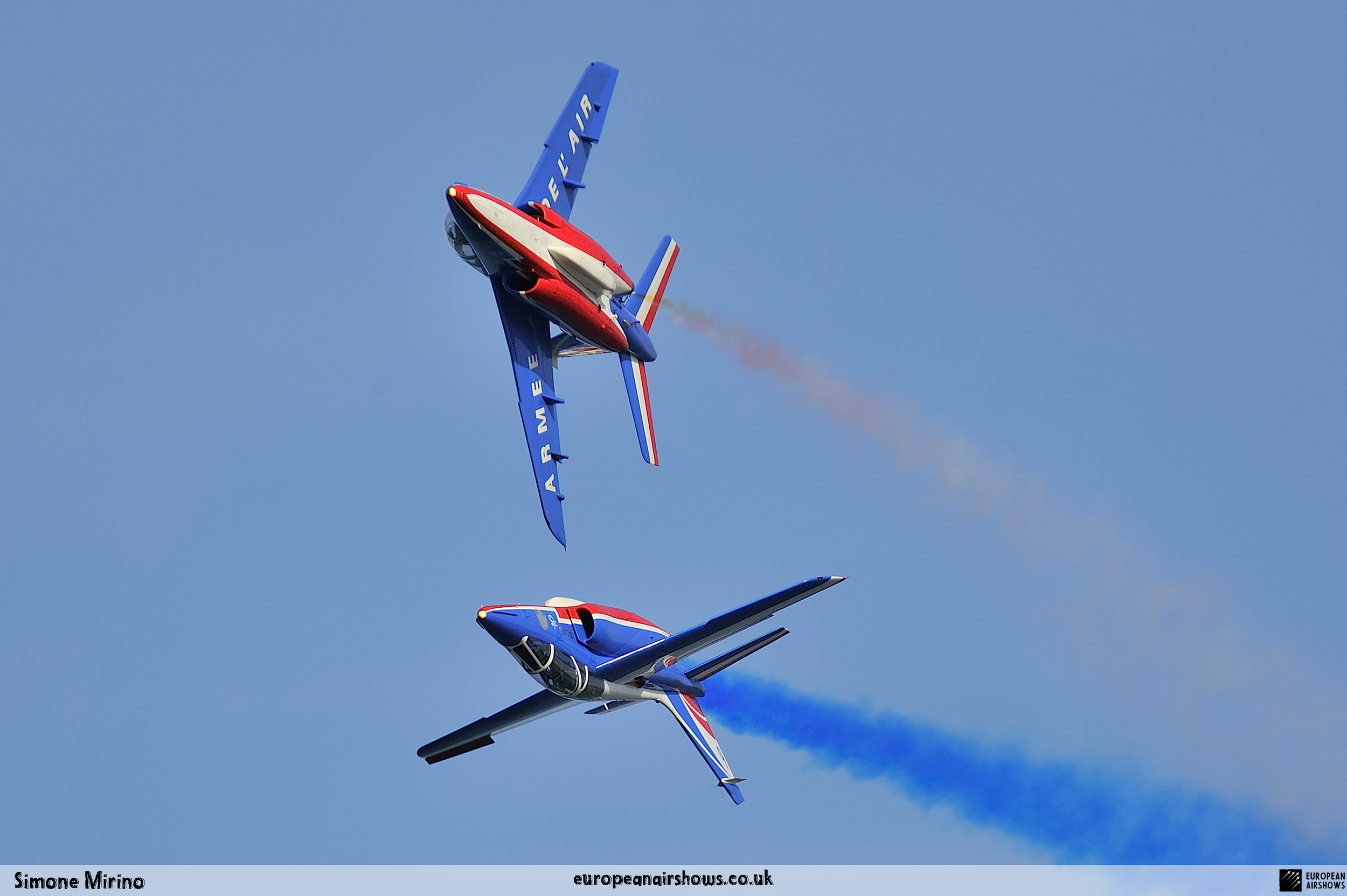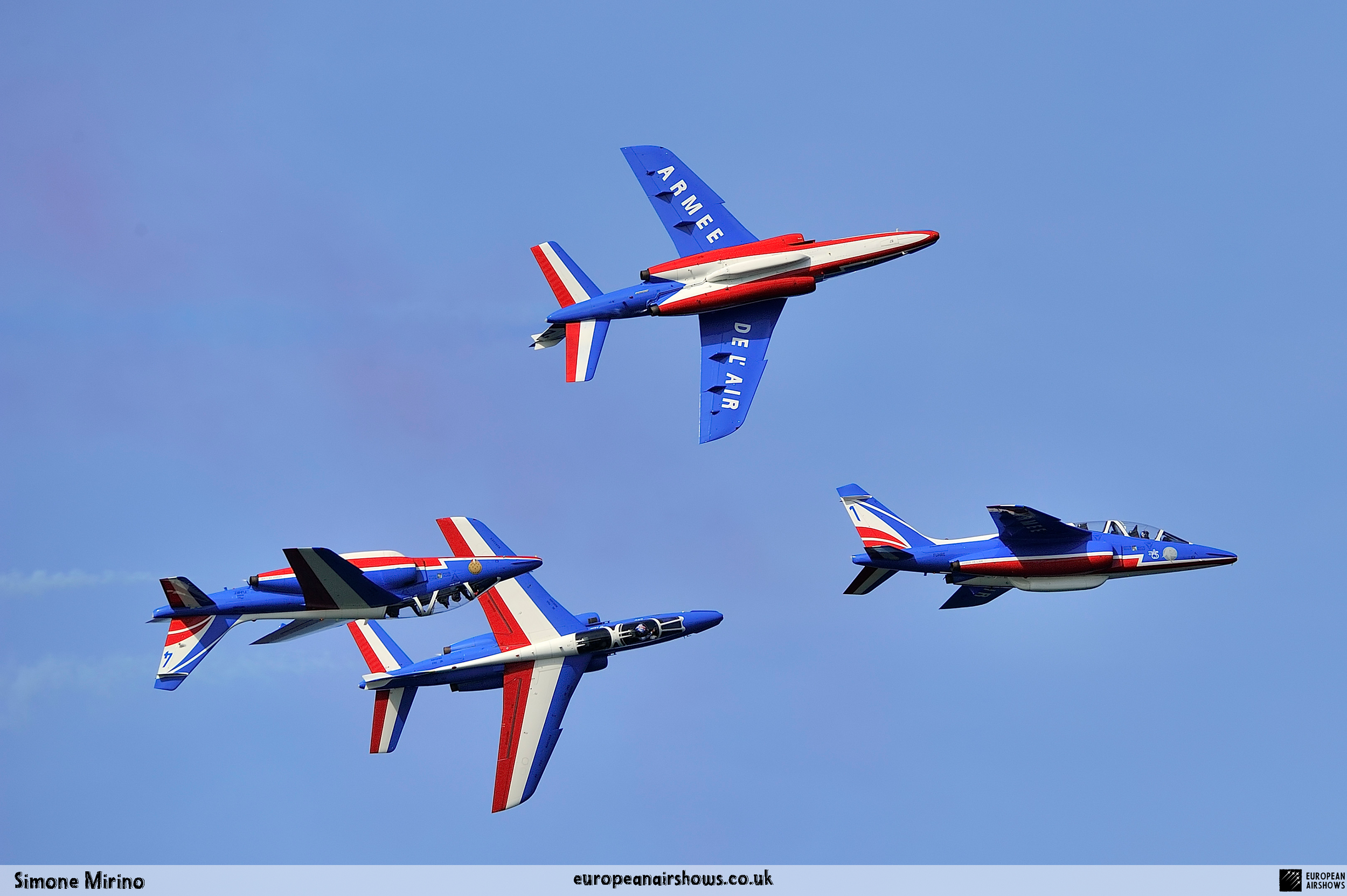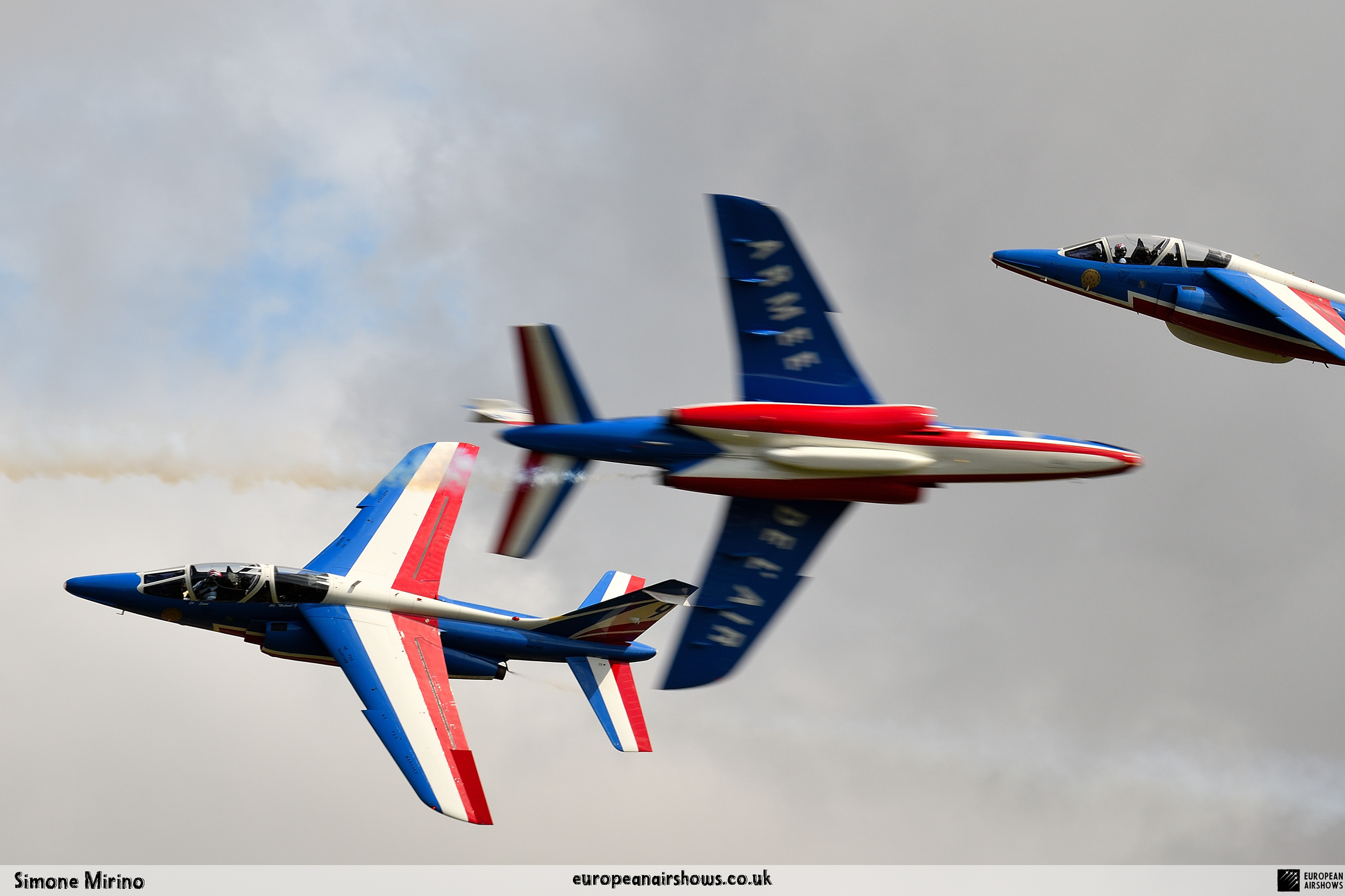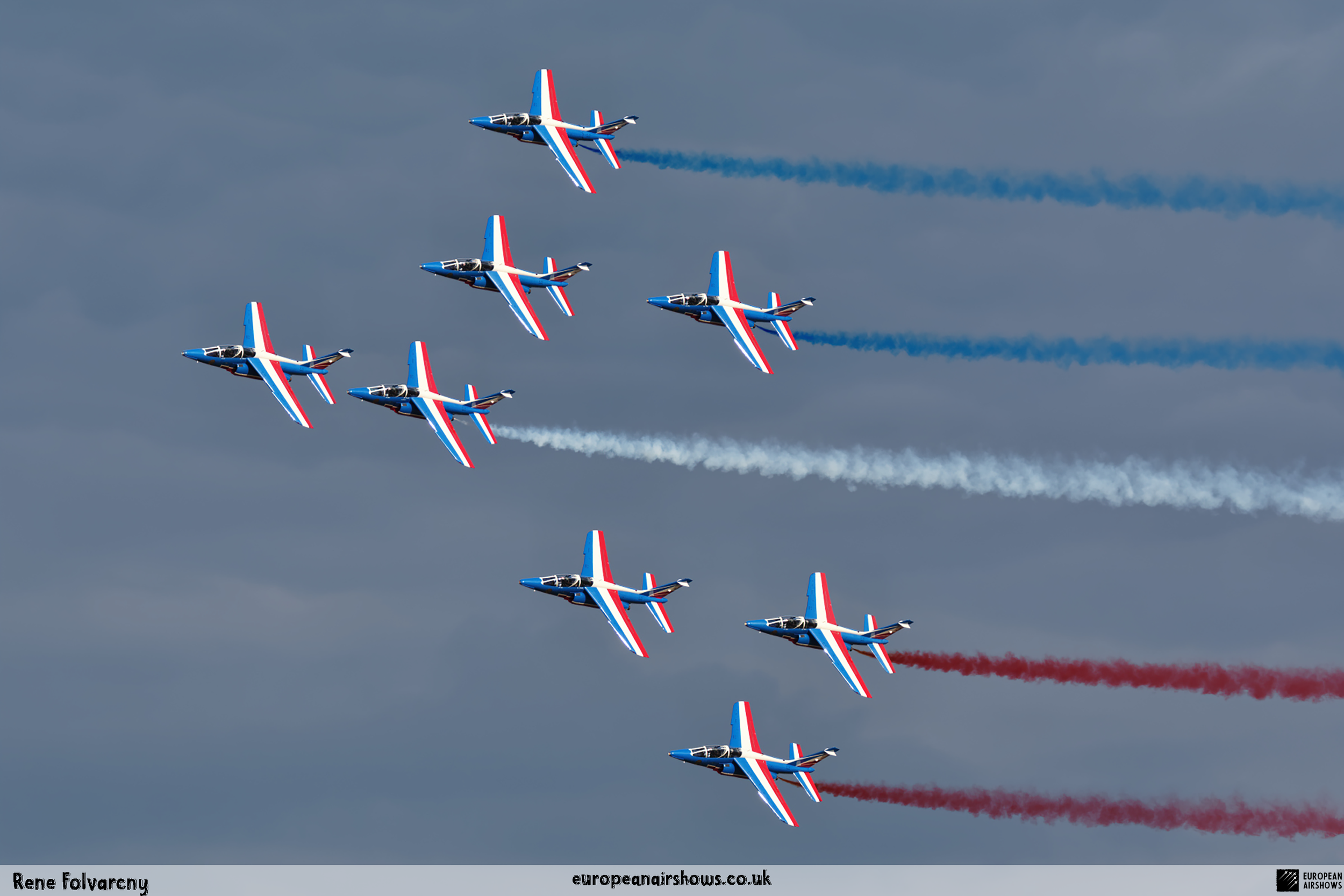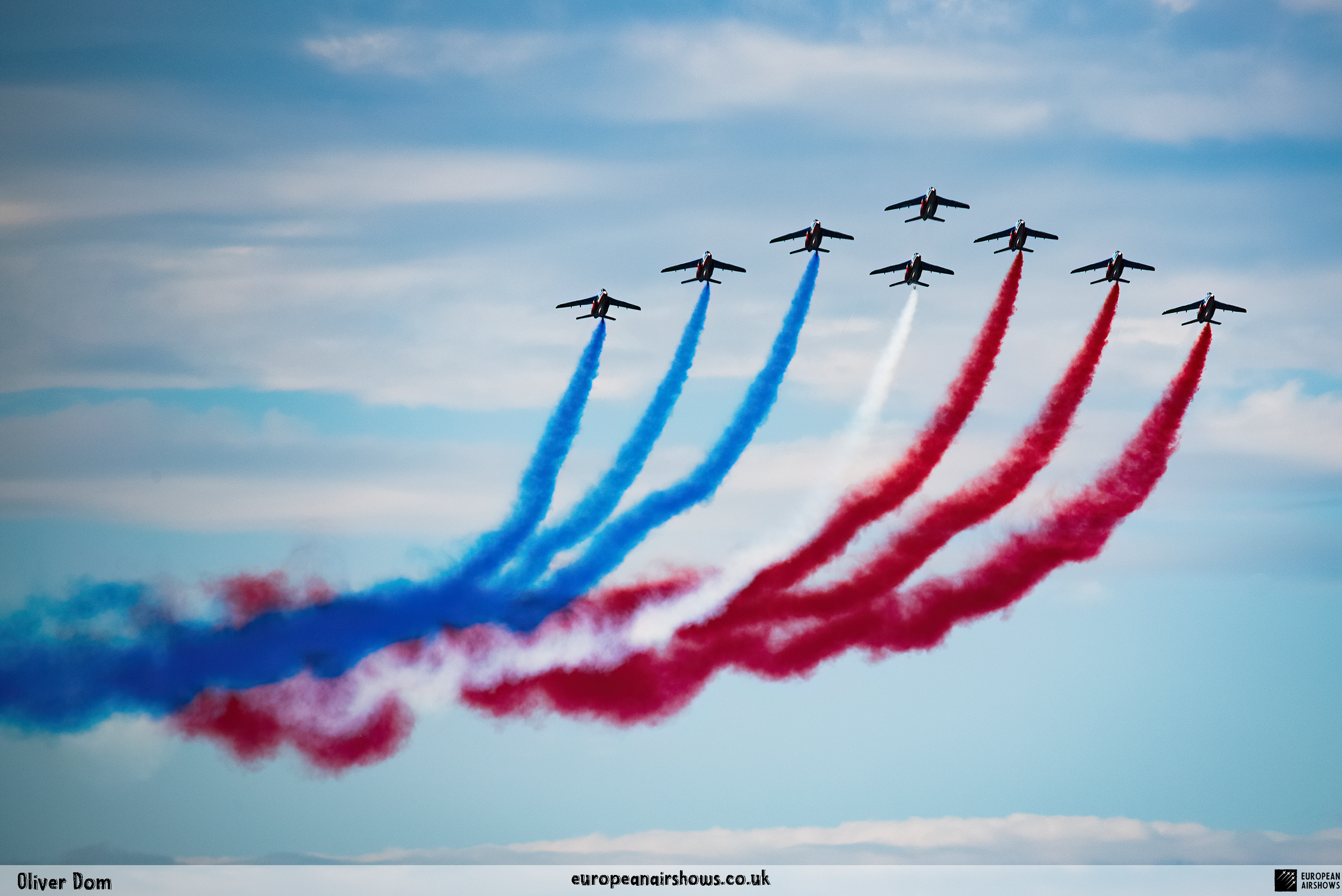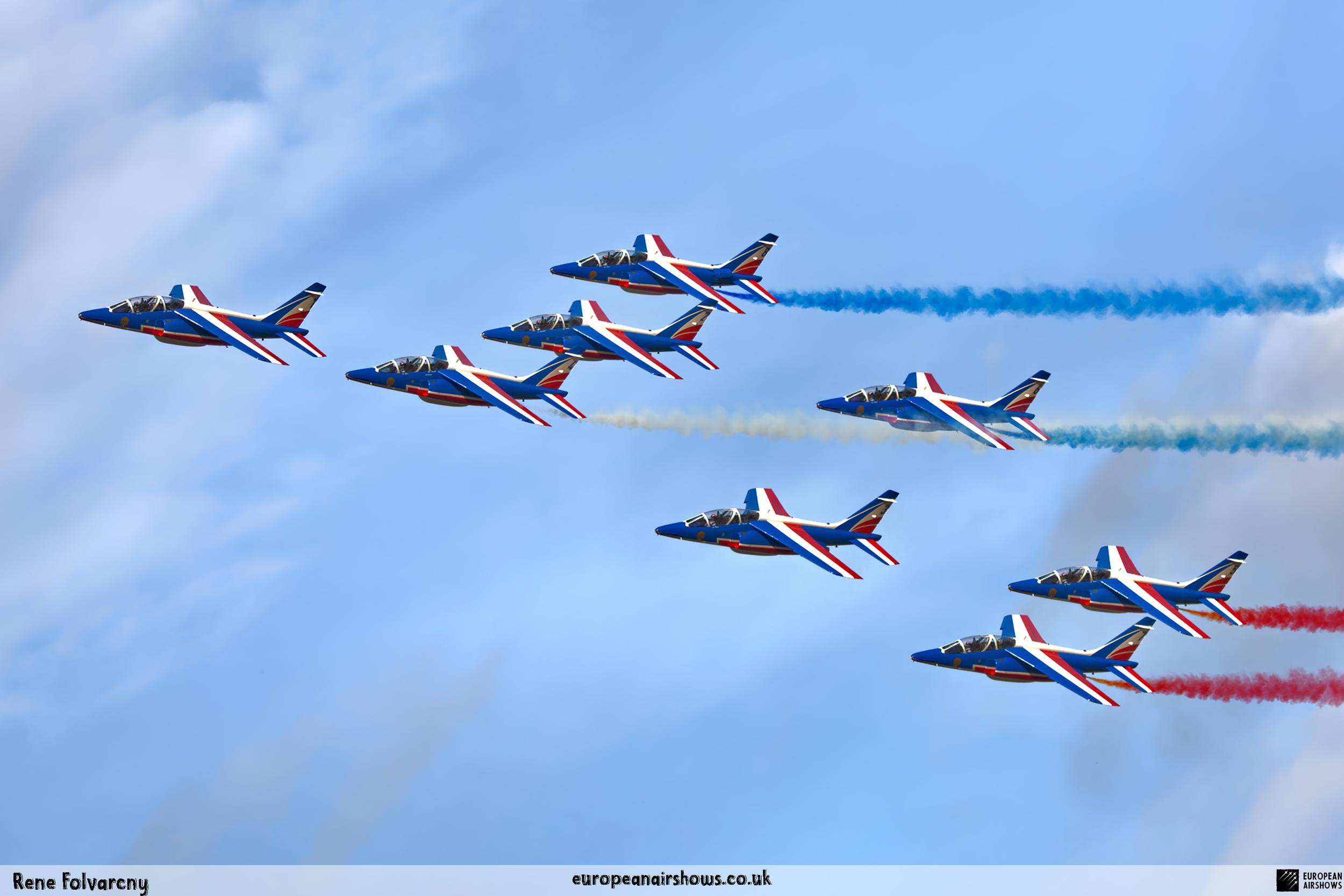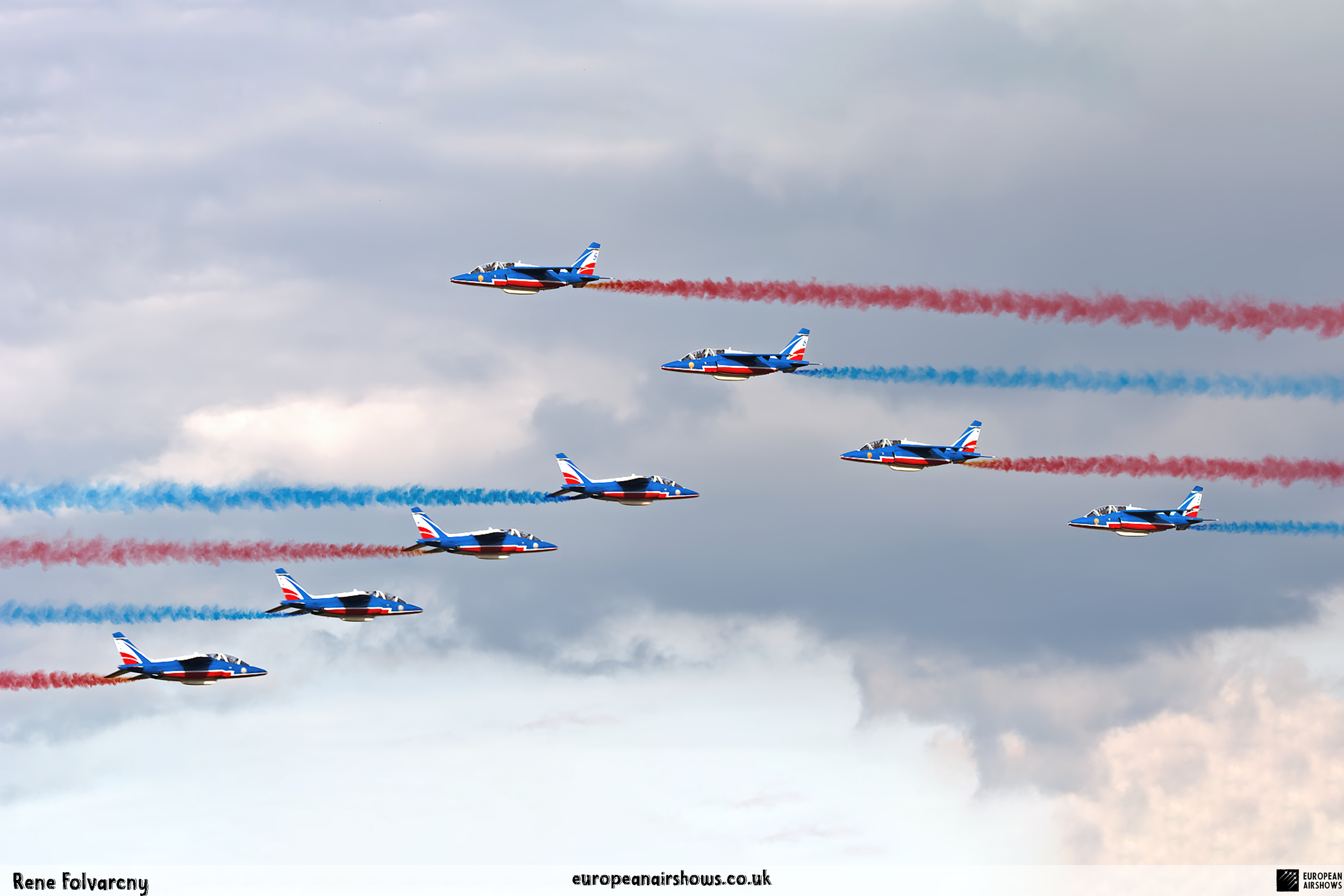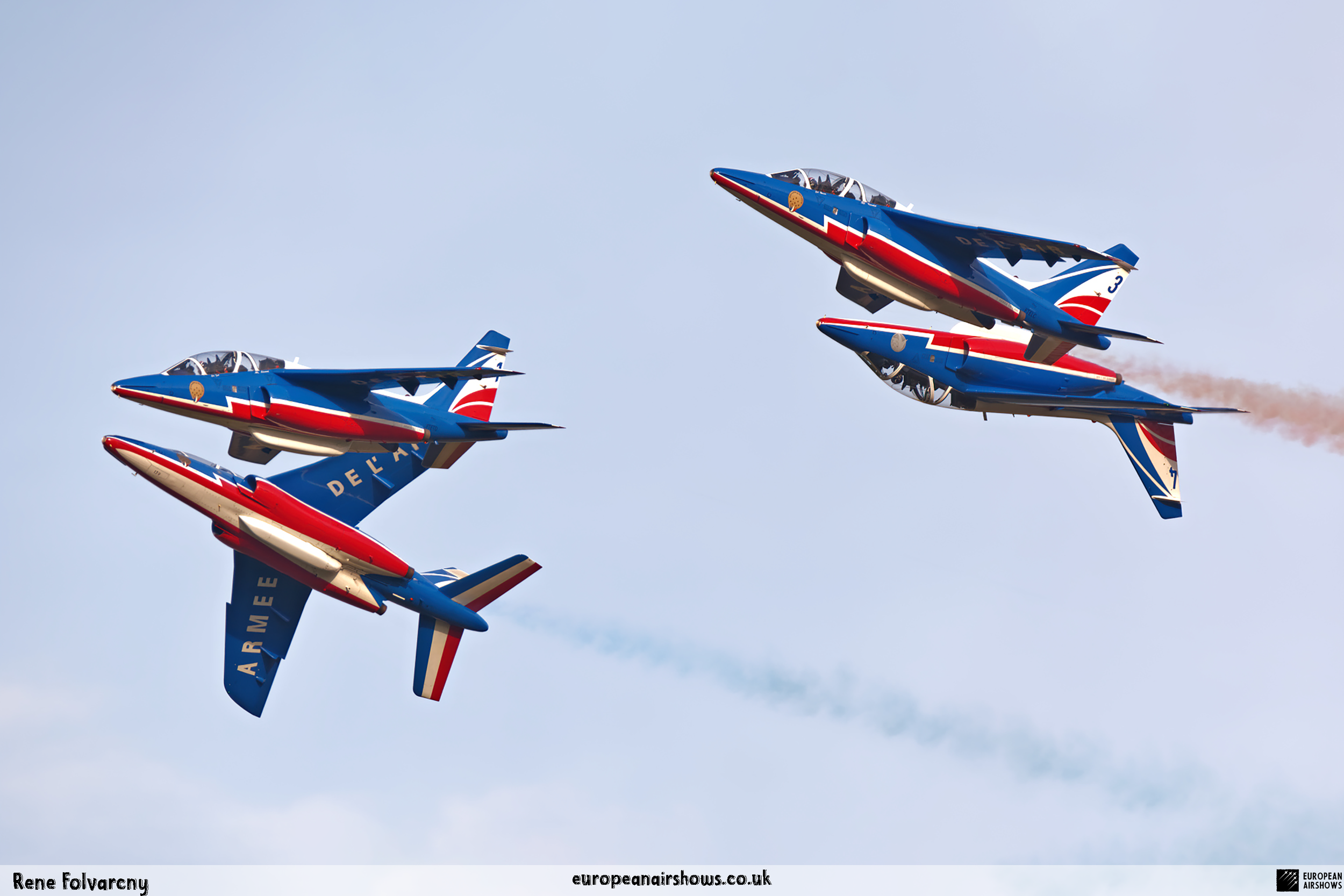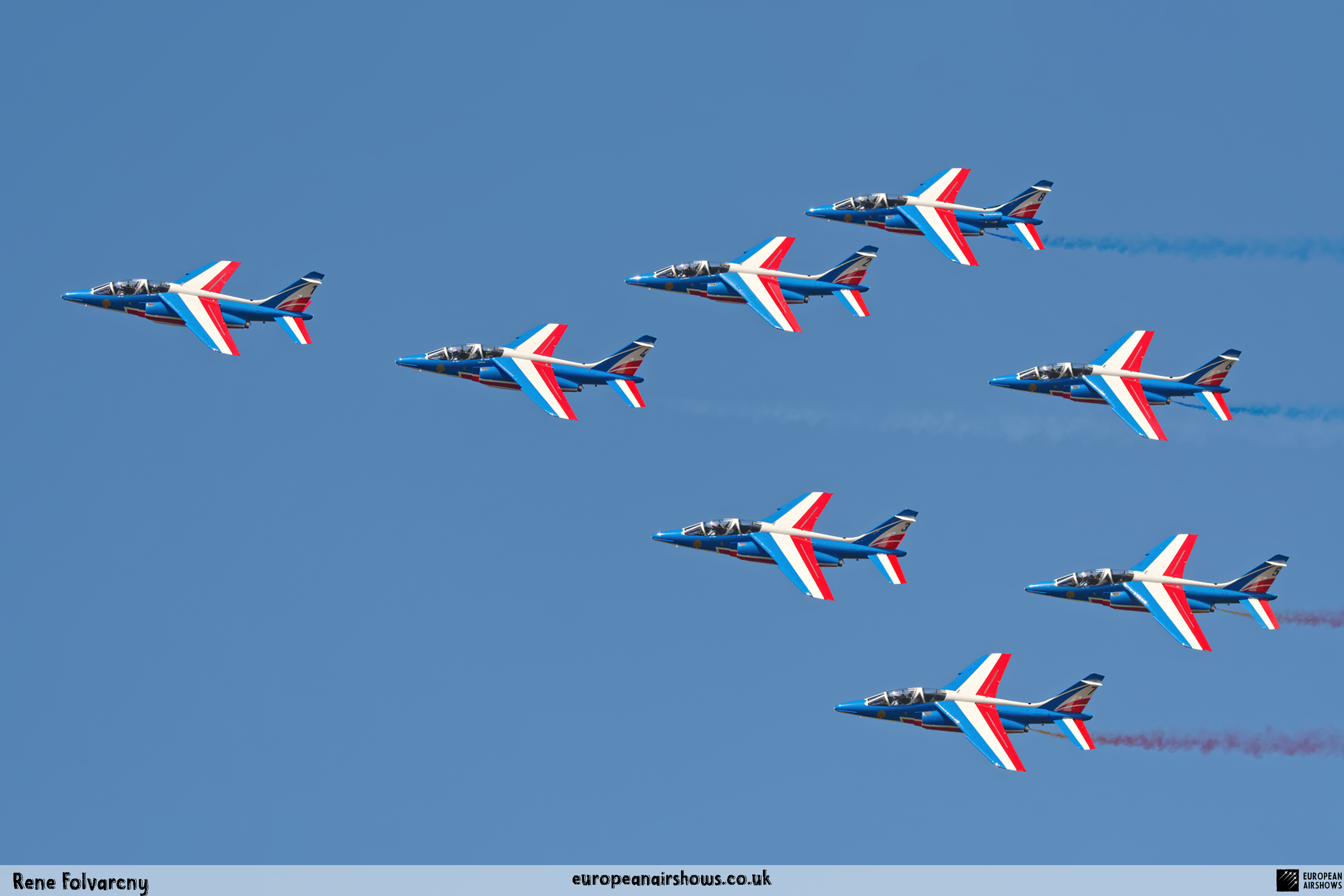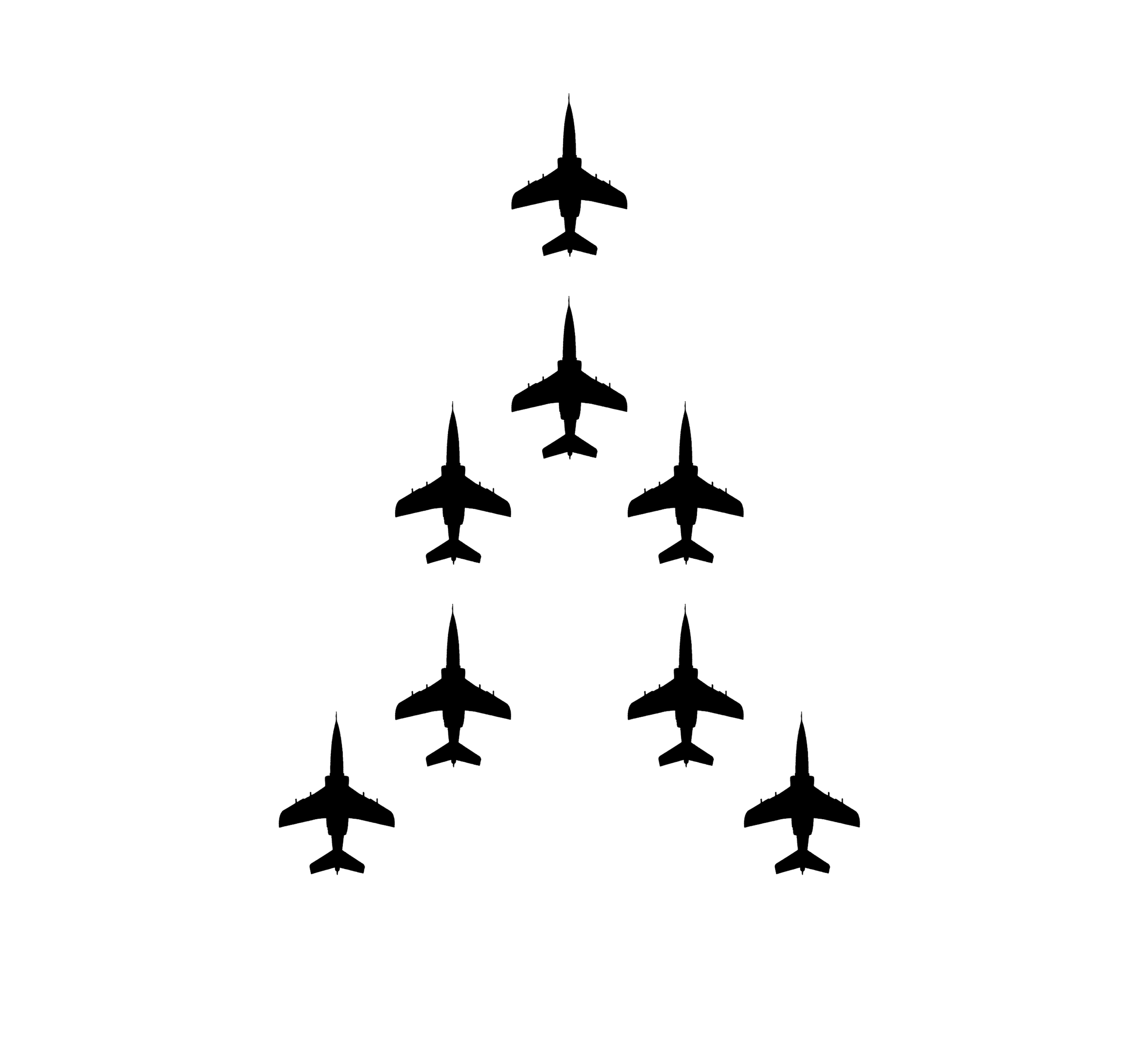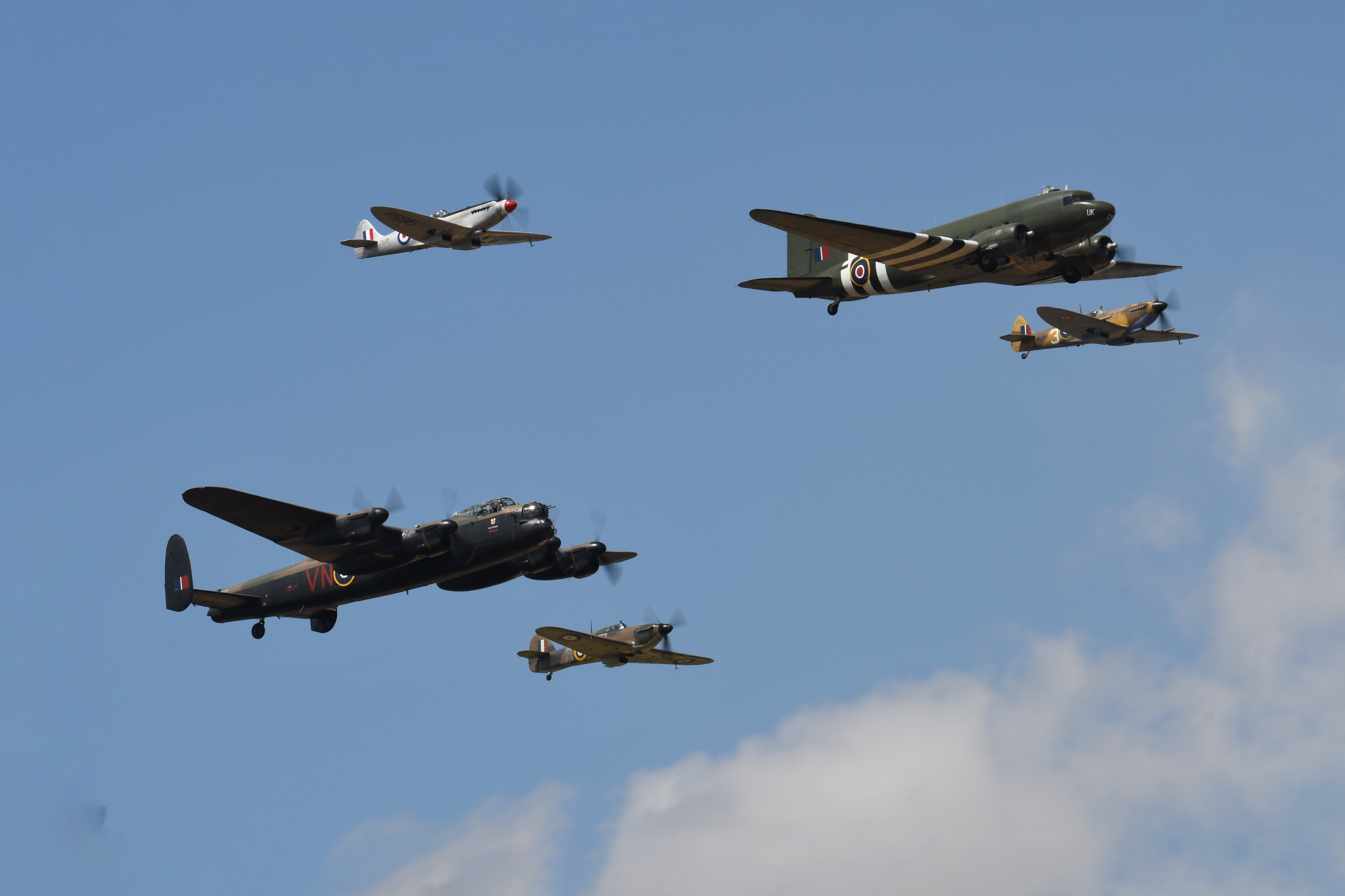Patrouille de France
Country
France
Size
8 Aircraft
Base
Salon-de-Provence Air Base
The Patrouille Acrobatique de France (French Acrobatic Patrol in French), also known as the Patrouille de France (PAF), is the precision aerobatics demonstration unit of the French Air and Space Force, officially commissioned in 1953.
Using the French Aerial Aerobatics unit of the French Air and Space Force, the mission is to represent it and lead the ambassadorship role of French aeronautics overseas. Stationed at Aerial Base 701 Salon-de-Provence in Bouches-du-Rhône, it is the oldest (active since 1931) and considered one of the best in the world. Comprising 9 pilots and 35 mechanics, the patrol (La Patrouille) splits its time between winter season training and summer season aerial displays.
The unit traditionally opens the Bastille Day military parade in Paris with 9 Alpha Jets, presenting a twenty-minute demonstration of formation changes and crossovers narrated by the director of the French Air Force presentation team, also a jet pilot as well as the public relations officer. Each manoeuvre is filmed by a photo and video specialist, as a pilot is also usually present (often the replacement pilot), supervising the communications between the PAF and the controller for flight safety.
In 1931, the first aerial demonstration took place at Étampes-Mondésir Airport. The demonstration was executed by instructors of the Piloting Perfection School, on Morane-Saulnier MS.230. The formation was composed of three aircraft. Between 1932 and 1939, under the command of Captain Pierre Fleurquin, the Patrouille d'Étampes received an encouraging success and entered in posterity. Accordingly, the Patrol was chosen to represent France during international meetings. In 1935, the Patrouille d'Étampes was converted on MS.225 and developed the capability to expand to five
aircraft. In 1937, the unit joined Salon-de-Provence; it was designated Patrouille de l'École de l'Air. The Second World War interrupted different activities.
In 1947, the Minister of Air created an escadrille of representation for the French Air Force. The presentation unit was directed by Captain Pierre, former pilot of the Patrouille d'Étampes and accordingly equipped with twelve Stampe SV-4. In front of the ongoing ascending success of presentations, diverse formations were put in place at the corps of the French Air Force. In 1952, Commandant Pierre Delachenal, pilot of the 3e Escadre, stationed at Aerial Base 112 Reims-Champagne, formed an escadrille of four Republic F-84G. During an aerial meeting on 17 May on the field of Maison-Blanche in Algeria, the pilot show commentator of the escadrille and journalist Jacques Nœtinger, overwhelmingly shocked with the spectacle which he had just witnessed, baptised France's Patrol officially as Patrouille de France. The general staff headquarters of the French Air Force accordingly confirmed this appellation on 14 September 1953
During the ten following years, four Escadres of the French Air Force perpetuated one after the other the traditions of the Patrouille de France and contributed to the patrol's international success. Nevertheless, in 1964, following budgetary restrictions, the patrol of Dassault Mystère IV was dissolved. Anxious not to have the designation of Patrouille de France disappear, the Minister of the Armies decided accordingly a couple of months later to adopt the Patrouille de l'École de l'Air.
The six Fouga Magister of the Aerial Base of Salon-de-Provence became the torch of French Aerial Aerobatics for sixteen years. The last presentation of Fouga Magister, which the number was nine, was held on 16 September 1980 at Salon-de-Provence. The Dassault/Dornier Alpha Jet became the steel spear of the Patrouille de France in 1981 with 7 aircraft. This number was increased to 8 as of 1982. A historical display took place in 1986 above New York City. On 25 November 2009, for the first time in the world, an aerobatic team was commanded by a woman, when Commandant of the French Air Force Virginie Guyot became the leader of the Patrouille de France.
| Back to Top |
Signature Formations
Apollo
Chevron
Diamond
| Back to Top |
Dassault/Dornier Alpha Jet E
The Dassault/Dornier Alpha Jet is a light attack jet and advanced jet trainer co-manufactured by Dassault Aviation of France and Dornier Flugzeugwerke of Germany. It was developed specifically to perform trainer and light attack missions, as well as to perform these duties more ideally than the first generation of jet trainers that preceded it. Following a competition, a design submitted by a team comprising Breguet Aviation, Dassault Aviation, and Dornier Flugzeugwerke, initially designated as the TA501, was selected and subsequently produced as the Alpha Jet.
Both the French Air Force and German Air Force procured the Alpha Jet in large numbers, the former principally as a trainer aircraft and the latter choosing to use it as a light attack platform. As a result of post-Cold War military cutbacks, Germany elected to retire its own fleet of Alpha Jets in the 1990s and has re-sold many of these aircraft to both military and civilian operators. The Alpha Jet has been adopted by a number of air forces across the world and has also seen active combat use by some of these operators.
The Alpha Jet is a light twin-engine aircraft equipped with an intentionally simple airframe despite the performance delivered. Both the leading edges and air intakes are fixed; while the aerodynamic shape of the aircraft, which was developed with the aid of computer-aided design, conforms with the area rule. Fully powered controls are used, comprising dual-hydraulic systems and load-factor limited dynamic feel system arrangement attached to conventional flight control surfaces. The cockpit is pressurised for greater comfort during training. The Alpha Jet is designed to accommodate ten-minute turnaround times with minimal ground equipment, using features such as pressurised single-point refuelling, ladder-less entering/egress of the cockpit, and a ten-hour endurance of the liquid oxygen system.
The Alpha Jet was designed to perform a diverse range of roles. The principal users of the type, Germany and France, operated their Alpha Jets in different capacities, the former as a ground attack platform and the latter as a trainer aircraft. Beyond performing different roles, the Alpha Jet fleets of France and Germany noticeably differed in their specification and equipment; German aircraft were fitted with a more extensive weapon-aiming system, a different fuel system, a yaw damper, different brakes, nosewheel steering, an arrester hook, and Stencel ejector seats in place of Martin-Baker. According to aerospace publication Flight International, the majority of the specialised equipment used on the ground attack-orientated variant of the Alpha Jet was provided by German firms. In addition to the ground attack role, the Luftwaffe also employed the Alpha Jet in the electronic countermeasures (ECM) and aerial reconnaissance roles; for the latter purpose, a reconnaissance pod could be fitted upon the port hardpoint.
The Alpha Jet is powered by a pair of SNECMA Turbomeca Larzac turbofan engines. It is a low bypass-ratio, the twin-spool engine that uses modular construction methods. The Larzac was a new engine at the time, having only performed its first run a year prior to being selected to power the Alpha Jet. The need for greater thrust to power the aircraft than the original model of the engine could generate led to the development and adoption of the 2,970 lb Larzac 04 in February 1972; it was this version of the engine that initially powered the Alpha Jet. Germany was interested in powering the type with the General Electric J85, but France objected to the use of an American engine which would result in US export restrictions upon the overall aircraft and agreed to assume the cost of developing the French-built Larzac. During the 1980s, an upgraded model of the Larzac engine which increased the thrust by 10 per cent was developed.
The avionics of the original version of the Alpha Jet was of an austere nature, partly to make it a simple and easily exportable aircraft. The basic type lacked features such as an autopilot, inertial navigation, or radar. Later upgrade programs would typically focus on the addition of a glass cockpit and other avionics systems. The Luftwaffe's Alpha Jets were equipped with additional avionics for the attack role, such as a Doppler radar and additional hardpoints. During the 1970s, Dornier claimed that the Alpha Jet outperformed aircraft used as the McDonnell Douglas F-4 Phantom II, LTV A-7 Corsair II, and the Fairchild Republic A-10 Thunderbolt II in the close air support role; the firms specifically stated that the Alpha Jet was smaller, faster, less vulnerable, more manoeuvrable, cheaper and had higher all-round performance than the A-10.
According to aerospace publication Flight International, the Alpha Jet was more complex than competing second-generation trainer aircraft, required seven man-hours of maintenance for every flight hour. Nearly 5,000lb of munitions and equipment may be carried upon a total of five hardpoints, four of these being located upon the wings and a single one at the centerline on the lower fuselage. In an armed configuration, a gun pod containing a 30 mm DEFA cannon (as installed on French aircraft) or a 27 mm Mauser BK-27 cannon (as installed on German aircraft) would typically be installed upon the centerline hardpoint.
| Back to Top |
